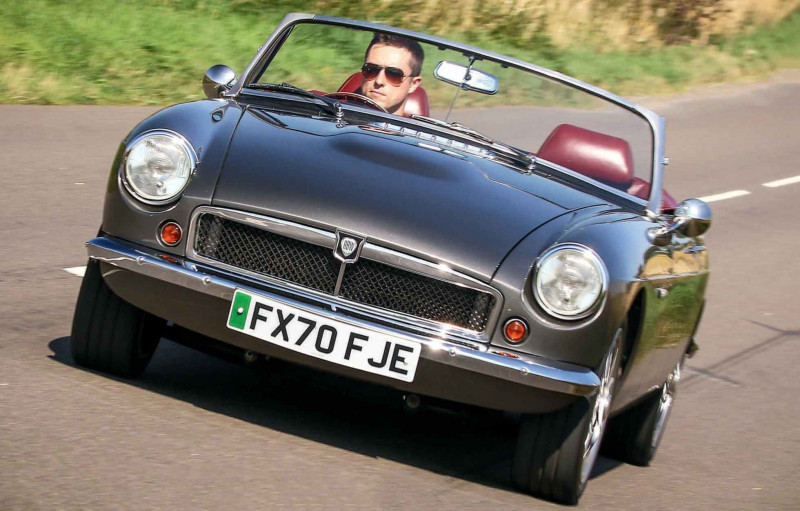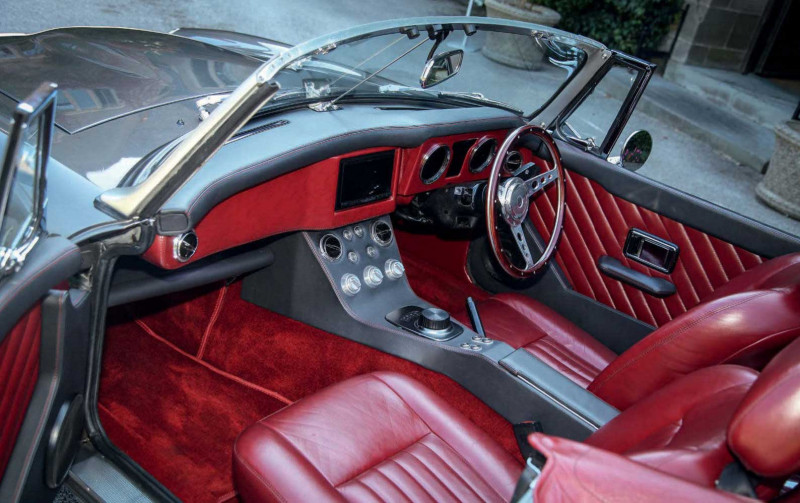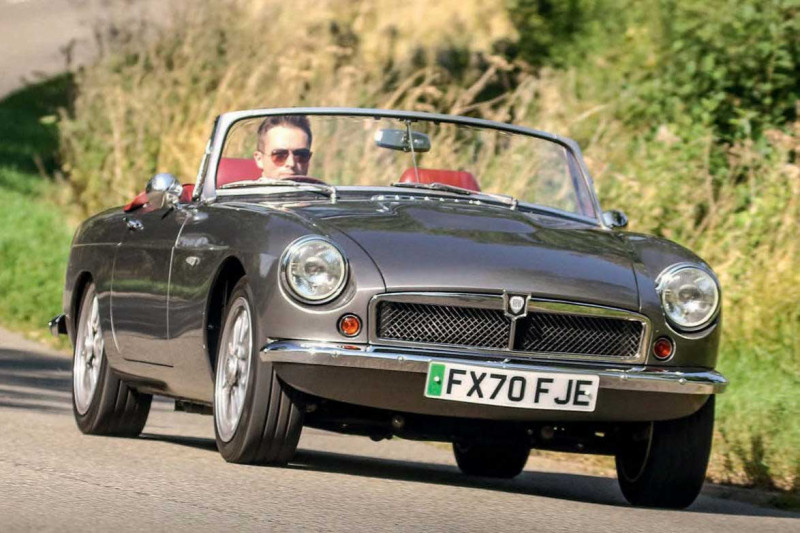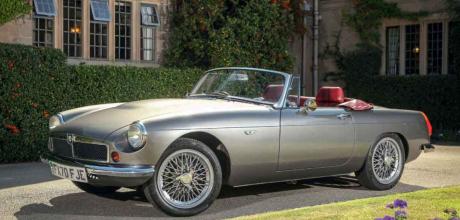RBW’s all-new, all-electric, MGB-style roadster
Using a Heritage bodyshell, but little else from an MGB, how does RBW’s all-electric roadster stack up as a driver’s car? Words: Aaron Mckay. Photos: Andy Starkey.
THE SILENT ROADSTER
OUR ELECTRIC FUTURE? We drive the £100k answer
We drive RBW’s all-new, all-electric, MGB-style roadster
No, it’s not an MGB,” my carloving friend says, and his sceptical eye goes over more of RBW’s retro roadster with dismissive furrowing of eyebrows. “No, no, I don’t get it. And how much is it again?” It is a lot of money, I admit.

Over £100,000 by the time you’ve added UK VAT and talked about exactly how you’d like to spec your car. “What’s wrong with a normal MGB?” he asks, exhaustedly. Looking at the basic specification, an all-electric car with a range of 160 miles that produces a modest 70kW of power (98bhp and 176lb.ft torque) for performance of just 80mph and an 8.9-second 0-60mph time isn’t all that impressive, it’s true. There is a longer range capability, with a seventh battery available as an option, but even that configuration’s 200-mile range remains only on a par with a standard, petrol MGB. As an electric conversion for an MGB roadster, then, the RBW seems a little underwhelming.
...IT COMES AS A SHOCK WHEN YOU JAB THE THROTTLE AND THE CAR LEAPS FORWARD IN THE BLINK OF AN EYE
However, RBW’s roadster is far more than a conversion. As you may well have read in the December 2020 issue of MG Enthusiast, this car shares only the (British Motor Heritage) bodyshell with the MGB roadster. The technical specification has been largely dictated by RBW’s clever tie-in with the automotive component giant Continental AG, working specifically with Continental Engineering Services (CES) and Zytek Automotive, then finished off with the work by specialist engineers directed by the CEO of RBW, Peter Swain. His standards for the car are high: “We want it to be a driver’s car so we’ve put thousands of hours into the drivetrain set-up and suspension dynamics, everything to perform just how a driver would want it to.” The RBW is officially brand new so has also had to meet today’s safety and emission regulations, with some accommodations made for it using an MGB shell. While that list price sounds very high, it is an achievement to have put together a low production- volume, new car like this at this price point.

Ours is a pre-production car, which means that there is some more finishing work to do on aesthetic details, particularly the interior, but the mechanical make-up of the car is now, apart from slightly softer (and adjustable) rear shock absorbers, representative of what customers can expect when they receive deliveries of their own – which is any time now.
The original roadster monocoque has been reinforced with strengthening bars in the forward bulkhead, then two custom-made subframes have been attached, rubber-bushed, mounting double-wishbone suspension all round. The wheelbase remains the same but track widths are up to 1264mm and 1270mm front and rear, 13mm and 19mm up from a standard 1962 MGB. Most of the suspension components are from a Volkswagen Golf Mk7, off-the-shelf items supplied by RBW’s development partner Continental, which have then been fine-tuned to suit. Parts-sharing extends all the way from the Nissan Leaf electric motor to the Jaguar-type rotary gear selector.
So does it feel at all like an MGB? There’s the unmistakeable shape and even that click of the original-specification door latch which promises authenticity, except there is something ‘off’ to the seasoned MG-spotter. Not only does it wear a different grille, sidelights and indicators but it sits ever so differently on the road. Inside, almost everything is different. You can trace the shape of an original MGB’s interior only from the dash top, which wraps around beneath the windscreen with luxuriously stitched leather. The seats are indeed from a later MGB, re-trimmed in rich leather, but most of the remainder is new. The leather door cards, diagonally striped and with a well-placed armrest below a late-model MGB door handle, do look expensive. A valiant attempt at a door-card pocket has been made and will accommodate a suitably light wallet.
THE RBW IS OFFICIALLY BRAND NEW SO HAS ALSO HAD TO MEET TODAY’S SAFETY AND EMISSION REGULATIONS, WITH SOME ACCOMMODATIONS MADE FOR IT USING AN MGB SHELL
The seatbelts are inertia reel units mounted from the rear bulkhead, by necessity, to meet safety regulations. They can uncomfortably dig into one’s shoulder at certain heights and, we found, tended to be easily obstructed by the roof when folded down. There’s lots of turned aluminium used for the switchgear, complementing this car’s black-on-red colour scheme. The dials are LCD screens programmed to display circles, so there remains something of an awkward square surround that breaks up the otherwise clean facia. A high-end Pioneer stereo sits dominant in the centre, offering Bluetooth connectivity and more.
A turn of the key lights up the dials in front of you and sets off a sequence of whirrs, with a couple of clicks, as the batteries and electric motor come to life. There’s a moment’s delay before you can select drive, via the rotary gear-selector, and actually set off. However, it’s only the amount of time that it takes to put your seatbelt on. The RBW then sets off silently and, thanks to a well-weighted throttle pedal, smoothly.

Despite the interior, you still expect this to drive like an MGB so it comes as a shock when you jab the throttle and the car leaps forward in the blink of an eye. After an initial rush of acceleration it tapers off and feels no more than its advertised 98bhp. It continues to surprise when you begin to turn the wheel. Much tighter body control is paired with geometry that simply pivots the car round corners with none of the attitude of a standard B. Making a dash through town is huge fun with this zippy character and you notice that quite a few people are moved to astonishment at the car’s silence.
Out in the countryside, the RBW’s strengths continue to reveal themselves. The steering is sharp, nicely weighted and even offers a bit of feel, while the lower seating position, which RBW has set to demonstrate how it can customise its cars to order, provides an even greater connection with the road beneath than a standard MGB. The relatively sophisticated chassis, with 185/50R16 tyres, delivers sensational traction too.
But the British B-road reveals some weaknesses, as it is so often able to do with ambitious sports cars. Where the shove of 176lb.ft of torque felt like all you could ever need in lower-speed town driving, acceleration tails off quite dramatically at higher speeds and can often leave you feeling vulnerable, particularly when overtaking. The RBW’s supreme traction also feels out of balance with the modest powertrain and you soon find yourself throwing momentum at corners and planting the throttle heavily rather than playing with the pedal’s fine response.
There are challenges offered by this chassis, too. Large bumps, particularly mid-corner, can suddenly breach the limited travel of the double-wishbone suspension and send you airborne. A slightly under-damped rebound stroke also allows a pitching movement fore and aft when you land. Of course, this is the sort of challenge that would also upset a standard MGB but, with more natural responses and softer springs, it would also be less frantic.
My final complaint is with the brakes. They’re strong and resist lock-up but the blending in and out of the regenerative function, combining with the discs and pads, is often clumsy. You can feather the pedal on the approach to a roundabout, for example, then suddenly the regenerative function will follow up to double the braking force. This prompts you to let off, then to go back on, searching for an elusive middle ground between light and heavy braking. I’m told that a lot of work has gone into tuning the regenerative system but it seems that there is more work to do, particularly since there is no driver control for the system.
As a car to blast down B-roads at full chat, the RBW falls some distance short. The loss of noise and engagement of a petrol engine and manual gearbox is significant but it’s more a case of balance between chassis and powertrain here. One is stronger than the other and it’s simply not as sweet a sports car as it could be – or is, in the case of the MGB. However, it’s only a few dynamic details and some interior finishing away from a wonderful countryside cruiser with fine driver responses. The interior is in preproduction form and the suspension can be tuned further and, perhaps, even to customer taste; in fact, it has undergone revision since our experiences here. Who that customer is also matters. I’m probably right in saying I haven’t swayed you to trade in your classic for this new breed of car any more than I could convince my friend at the beginning. The reaction of many others to the RBW was just as positive as we can be negative. “Now, I like this one,” my neighbour said, with wide eyes. “I love the interior, very plush,” she pursued. I had a similar reaction from many others; lots of thumbs-ups and expressions of wonder from the pavement, compliments and questions from the car parks, if not petrol stations. The RBW is probably not for us and it’s also probably not quite right to refer to it as the £100,000 electric MGB.
Instead, it is a new, electric retro-roadster built in the shape of one of the most elegant 1960s sports cars ever made. To the person on the street, £100,000 probably sounds about right and, for that reason, I think RBW might well be onto something here.
THANKS TO: Thanks to the staff at the Mallory Court Hotel and Spa near Leamington Spa, Warwickshire for allowing us onto their lovely grounds for the photoshoot. For more info. see their website: www.mallory.co.uk/
Few signs of the original MGB interior remain. Instead there is a more resto-mod flavour to the RBW’s luxuriously trimmed cabin.
It looks pretty good for what Peter Swain describes as ‘a pre-production state, not finished', particularly in red and black.
Modern rotary gear-selector is lifted from the Jaguar catalogue at Continental’s large parts bin.
Electronic dials are neat and simple, with clear and smooth indication of what the powertrain is doing, but are missing some key information like distance to empty and the graphics could be a little more decorative to please the eye.
Ancillaries are neatly tucked to the side of the large battery pack up front. Most of the batteries live up front, under the bonnet, and represent roughly the same weight as a standard MGB's engine; total weight distribution is 52% front, 48% rear.
The charging terminal is quietly tucked into a corner of the rear and covered by a retro-styled aluminium screw-top. Wire wheels wear 185/50R16 tyres, by Continental of course, which are partly responsible for the RBW’s exceptional levels of traction.
Boot space is invaded by one of two battery packs and a charge cable in a neat leather bag but still offers just enough space for a weekend away. The electric motor is integrated into the rear axle, making the RBW technically rear-engined.


